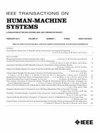Robust Object Selection in Spontaneous Gaze-Controlled Application Using Exponential Moving Average and Hidden Markov Model
IF 3.5
3区 计算机科学
Q2 COMPUTER SCIENCE, ARTIFICIAL INTELLIGENCE
引用次数: 0
Abstract
The human gaze is a promising input modality for interactive applications due to its advantages: giving benefits to motion-impaired people while providing faster, intuitive, and easy interaction. The most common form of gaze interaction is object selection. During the last decade, gaze gestures and smooth pursuit-based interaction have been emerging techniques for spontaneous object selection in various gaze-controlled applications. Unfortunately, the challenge of spontaneous interaction demands no prior gaze-to-screen calibration, which leads to inaccurate object selection. To overcome the accuracy issue, this article proposes a novel method for spontaneous gaze interaction based on Pearson product-moment correlation as a measure of similarity, an exponential moving average filter for signal denoising, and a hidden Markov model to perform eye movement classification. Based on experimental results, our approach yielded the best object selection accuracy and success time of使用指数移动平均法和隐马尔可夫模型在自发凝视控制应用中进行稳健的目标选择
人类凝视是一种很有前途的交互应用输入模式,因为它具有以下优势:既能为行动不便的人带来好处,又能提供更快、更直观、更简便的交互。最常见的凝视交互形式是选择对象。在过去十年中,凝视手势和基于平滑追逐的交互技术已成为各种凝视控制应用程序中用于自发选择对象的新兴技术。遗憾的是,自发交互的挑战在于不需要事先进行凝视到屏幕的校准,这导致了对象选择的不准确。为了克服准确性问题,本文提出了一种新的自发凝视交互方法,该方法基于皮尔逊积矩相关性(Pearson product-moment correlation)作为相似性度量,指数移动平均滤波器(exponential moving average filter)用于信号去噪,隐马尔可夫模型(hidden Markov model)用于眼动分类。根据实验结果,我们的方法获得了最佳的对象选择准确率和成功时间,分别为 $\text{89.60}\pm \text{10.59}\%$ 和 $\text{4364}\pm \text{235.86}$ ms。我们的研究结果表明,只要仔细考虑处理眼动仪产生的噪声数据的基本技术,凝视控制应用的自发交互是有可能实现的。此外,所提出的方法对于未来开发符合世界卫生组织 COVID-19 大流行期间卫生协议的交互式无触摸显示系统大有可为。
本文章由计算机程序翻译,如有差异,请以英文原文为准。
求助全文
约1分钟内获得全文
求助全文
来源期刊

IEEE Transactions on Human-Machine Systems
COMPUTER SCIENCE, ARTIFICIAL INTELLIGENCE-COMPUTER SCIENCE, CYBERNETICS
CiteScore
7.10
自引率
11.10%
发文量
136
期刊介绍:
The scope of the IEEE Transactions on Human-Machine Systems includes the fields of human machine systems. It covers human systems and human organizational interactions including cognitive ergonomics, system test and evaluation, and human information processing concerns in systems and organizations.
 求助内容:
求助内容: 应助结果提醒方式:
应助结果提醒方式:


